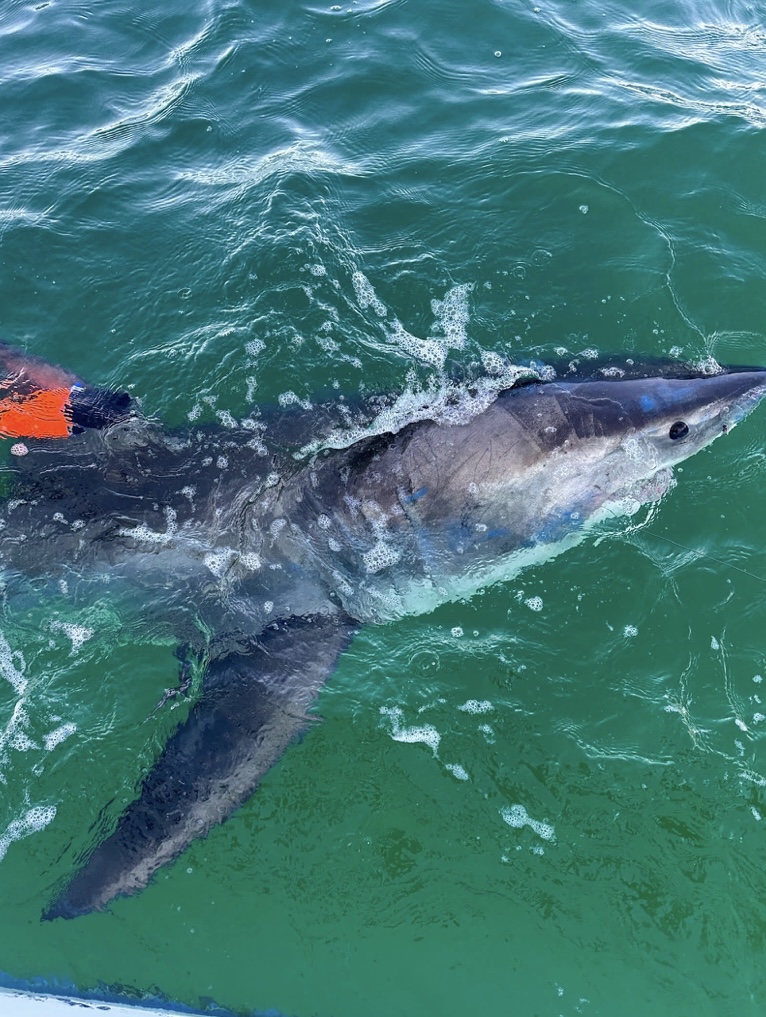
Cape Cod shark researchers get ‘shark’s-eye’ view after putting camera tag on great white
Cape Cod shark researchers get to go for yet another ride on the back of a great white after recently putting a camera tag on an apex predator.
The Atlantic White Shark Conservancy has deployed the second-ever camera tag on a great white shark off the Southeast.
AWSC staff scientist Megan Winton again worked with Outcast Sport Fishing’s Chip Michalove to clamp the device to the dorsal fin of a 9-foot female white shark off the South Carolina coast.
“The camera tag provides a ‘shark’s-eye’ view and includes sensors that record data on the shark’s movements and environment,” the Atlantic White Shark Conservancy posted.
After a day, the entire device detaches and floats to the surface — where it transmits its location via a GPS beacon, so researchers can retrieve it.
The video footage shows the top of the head of the great white shark.
Through camera tags, the researchers are able to get a glimpse into the shark’s behavior, their environment, dive pattern, and see small fish hanging next to the shark.
Late last year, Winton and Michalove tagged a massive shark — named “LeeBeth” — with the first camera tag ever put on a white shark off the southeastern coast of the U.S.
In addition to this second-ever camera tag, the team also deployed a fin-mounted satellite tag that will transmit the shark’s location to overhead satellites in real time when its dorsal fin breaks the water’s surface.
The new shark is now available for tracking on the Sharktivity app. The shark was detected off South Carolina — between Charleston and Myrtle Beach — on Monday.
“The data collected will be used by AWSC to learn more about how white sharks use the waters off the Carolinas and why they gravitate to the region in the winter and spring,” the Conservancy posted.
Related Articles
Boston’s Whale Jam concert blends great work, great tunes
Redfern: Vessels must hit the brakes, not right whales
Sharks ‘adapting their movements and routines,’ great white researchers discover
Cape Cod shark researchers ID nearly 100 ‘new’ great whites: ‘One of the largest photo-ID databases of individual white sharks worldwide’
Sharks scavenge carcass of another North Atlantic right whale found dead off East Coast
AWSC has successfully deployed the second-ever camera tag on a great white shark off the southeast US! Working with @ChipHHI, AWSC scientist @MegalodonWinton was able to clamp the device to the dorsal fin of a 9-foot female white shark off the South Carolina coast. pic.twitter.com/IsnHjiDCdh
— Atlantic White Shark Conservancy (@A_WhiteShark) April 23, 2024
Great whites over the next few months will be returning to Cape Cod, where they hunt for seals. The apex predators also eat more than marine mammals, the Conservancy posted in a new educational video.
“White sharks are really opportunistic predators,” Winton said. “They don’t only eat seals. They don’t only eat marine mammals.
“The bulk of their diet is actually made up of fish, squid, other smaller shark and ray species,” the researcher added. “And one thing that’s really interesting about white sharks is their diet actually changes with size, so they start incorporating marine mammals into their diet when they’re about 9 or 10 feet long.”
The camera tag provides a “shark’s-eye” view and records data on the shark’s movements. (Atlantic White Shark Conservancy photo)


